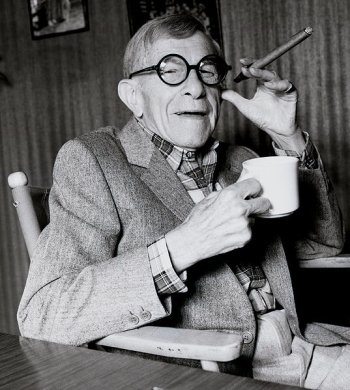
George Burns made no movies between Honolulu in 1939 and The Sunshine Boys in 1975.
When Esquire asked why, he said, “My agent was afraid of overexposure.”

George Burns made no movies between Honolulu in 1939 and The Sunshine Boys in 1975.
When Esquire asked why, he said, “My agent was afraid of overexposure.”
In deciding the 1972 case Flood v. Kuhn, which challenged the reserve clause in baseball players’ contracts, Justice Harry Blackmun waxed a bit rhapsodic, listing the players whom he felt deserved immortality:
Then there are the many names, celebrated for one reason or another, that have sparked the diamond and its environs and that have provided tinder for recaptured thrills, for reminiscence and comparisons, and for conversation and anticipation in-season and off-season: Ty Cobb, Babe Ruth, Tris Speaker, Walter Johnson, Henry Chadwick, Eddie Collins, Lou Gehrig, Grover Cleveland Alexander, Rogers Hornsby, Harry Hooper, Goose Goslin, Jackie Robinson, Honus Wagner, Joe McCarthy, John McGraw, Deacon Phillippe, Rube Marquard, Christy Mathewson, Tommy Leach, Big Ed Delahanty, Davy Jones, Germany Schaefer, King Kelly, Big Dan Brouthers, Wahoo Sam Crawford, Wee Willie Keeler, Big Ed Walsh, Jimmy Austin, Fred Snodgrass, Satchel Paige, Hugh Jennings, Fred Merkle, Iron Man McGinnity, Three-Finger Brown, Harry and Stan Coveleski, Connie Mack, Al Bridwell, Red Ruffing, Amos Rusie, Cy Young, Smoky Joe Wood, Chief Meyers, Chief Bender, Bill Klem, Hans Lobert, Johnny Evers, Joe Tinker, Roy Campanella, Miller Huggins, Rube Bressler, Dazzy Vance, Edd Roush, Bill Wambsganss, Clark Griffith, Branch Rickey, Frank Chance, Cap Anson, Nap Lajoie, Sad Sam Jones, Bob O’Farrell, Lefty O’Doul, Bobby Veach, Willie Kamm, Heinie Groh, Lloyd and Paul Waner, Stuffy McInnis, Charles Comiskey, Roger Bresnahan, Bill Dickey, Zack Wheat, George Sisler, Charlie Gehringer, Eppa Rixey, Harry Heilmann, Fred Clarke, Dizzy Dean, Hank Greenberg, Pie Traynor, Rube Waddell, Bill Terry, Carl Hubbell, Old Hoss Radbourne, Moe Berg, Rabbit Maranville, Jimmie Foxx, Lefty Grove. The list seems endless.
Justices Warren Burger and Byron White dissented from Blackmun’s list — but they declined to say whether they felt it was overinclusive, underinclusive, or irrelevant.

Edward B. Kaplan patented a unique idea in 1995: a braille slot machine.
A pad of pins corresponds to each reel in the machine; as the reels spin, the braille display changes under the player’s fingers until the winning combination is displayed. If the player wins, the machine vibrates slightly.
Any winnings are credited to the machine until the player presses a payout button. “This will also deter any theft from any other individuals.”

Hugh “One-Arm” Daily lost his left arm in a gun accident but went on to win 73 games as a professional pitcher between 1882 and 1887, including a no-hitter.
Mordecai “Three-Finger” Brown (above) lost two fingers in farm machinery as a boy but pitched for 13 seasons between 1903 and 1916, finishing with 1,375 strikeouts.
Pete Gray lost his right arm in a wagon accident but played briefly for the St. Louis Browns in 1945, fielding with a glove but transferring the ball to his bare hand to throw.
A reporter once asked Brown whether lacking a finger made it harder to pitch. “Don’t know,” he said. “Never done it the other way.”

NASA’s Cassini spacecraft took this photo while orbiting Saturn in 2005.
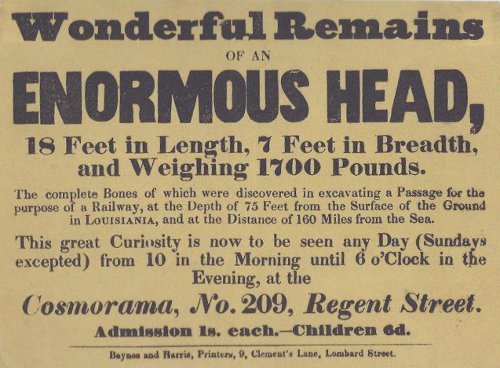
Magician, actor, and author Ricky Jay collects the broadsides that publicized bygone exhibitions of conjuring, acrobatics, curiosities, and feats of strength. These are two of his favorites, featured in his 2005 collection Extraordinary Exhibitions. According to one account, the Frenchmen who exhibited the “enormous head” were “cautiously noncommittal” as to whether it had belonged to a gigantic bird, fish, or lizard. And the playbill below presents three words that Jay finds “endlessly appealing. I love the way they look on the page. I love the way they roll off the tongue. No matter how much one is mired in the complexities of life, no matter how seriously one is inclined to take oneself, no matter how depressing are the day’s events — these vicissitudes are all assuaged by the presence of ‘The Giant Hungarian Schoolboy.'”
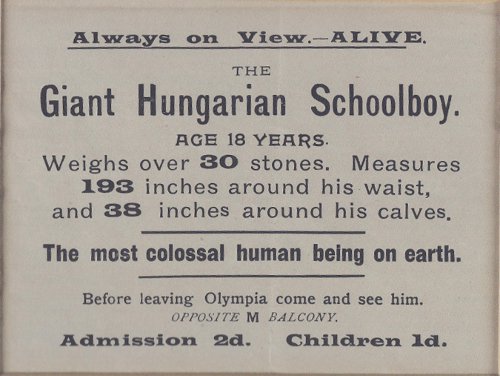
The chess clubs of Paris and Marseilles played a dramatic correspondence game in 1878. As White, Paris agreed to play without a queen. In return, Marseilles undertook to lose — to force Paris to checkmate them. Impressively, Marseilles succeeded:
1.d4 d5 2.Nc3 c6 3.Nf3 g6 4.e4 e6 5.e5 Bb4 6.Bd2 Bxc3 7.Bxc3 b5 8.h4 h5 9.0-0-0 a6 10.Ng5 f5 11.g3 Nh6 12.Bd3 Nf7 13.Bxf5 gxf5 14.Nxf7 Kxf7 15.Bd2 Nd7 16.Rhe1 c5 17.dxc5 Nxc5 18.Bg5 Qg8 19.Re3 Bb7 20.Rc3 Rc8 21.Be3 Nd7 22.Bd4 Rxc3 23.bxc3 a5 24.Kd2 a4 25.Rb1 Ba6 26.Rg1 Qg4 27.Rb1 Rc8 28.Rb4 Rc4 29.Rxc4 dxc4 30.a3 f4 31.Kc1 fxg3 32.fxg3 Qxg3 33.Kb2 Qxh4 34.Kc1 Qe1+ 35.Kb2 Qd1 36.Ba7 Nxe5 37.Bc5 h4 38.Bd4 Nc6 39.Be3 e5 40.Bf2 h3 41.Bg3 e4 42.Bf4 Ke6 43.Bg3 e3 44.Bf4 e2 45.Bg3 Kd7 46.Bh2 e1(Q) 47.Bf4 Qee2 48.Bg3 Qdxc2+ 49.Ka1 Qf1+ 50.Be1 Qd2 51.Kb1 h2 52.Ka1 h1(Q) 53.Kb1 Qf8 54.Ka1 Qxa3+ 55.Kb1 Qad6 56.Ka1 Qf6 57.Kb1 Kc7 58.Ka1 b4 59.Kb1 b3 60.Ka1 Kb6 61.Kb1 Ka5 62.Ka1 Ne7 63.Kb1 Nc8 64.Ka1 Bb5 65.Kb1 Qa6 66.Ka1 Nb6 67.Kb1 Qh7+ 68.Ka1
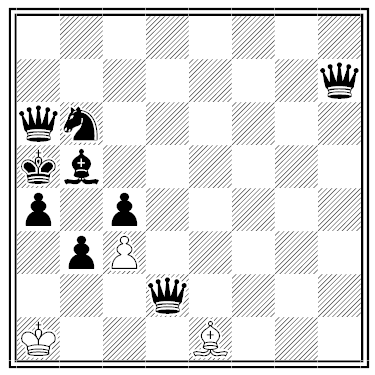
68. … Qxc3+ 69.Bxc3#
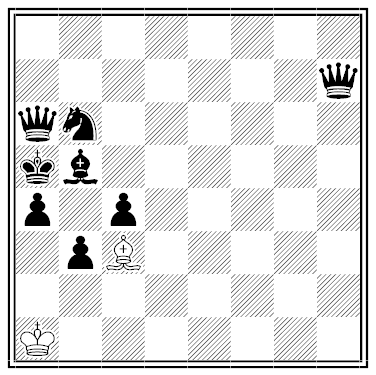
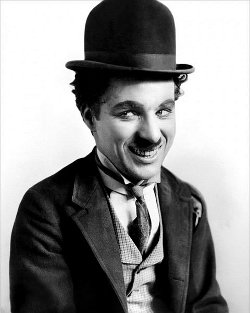
A group of us had gone to the pier to have dinner at a little fish restaurant, and while waiting to be served, Charlie Chaplin noticed a sign across the way that read, ‘Scientific Handwriting Analysis. Ten Cents.’ Charlie decided, as a joke, to try the expert out. Aldous [Huxley] stopped him. It would be too simple for a swami to ‘read’ for Charlie because his appearance was familiar to practically everyone in the world. On the other hand no one would recognize Aldous. So Charlie wrote a few words on a scrap of paper which Aldous took to the lady. He returned from his interview in a mood of deep concentration and reported what had happened. The lady had studied the writing a moment and then looked up at Aldous suspiciously. ‘Are you trying to make fun of me, sir?’ she asked. Aldous assured her he was not and wanted to know why she asked. She paused and studied Charlie’s writing more closely. Then, still suspicious, she asked, ‘Did you write this while you were in an unnatural or cramped position?’ Aldous then admitted that the writing was not his own but he assured the lady that it had been done quite normally. ‘Then,’ said the expert, ‘I don’t know what to say, because if what you tell me is true, the man who wrote this is a God-given genius.’
— Anita Loos in Aldous Huxley: A Memorial Volume, ed. Julian Huxley, 1965
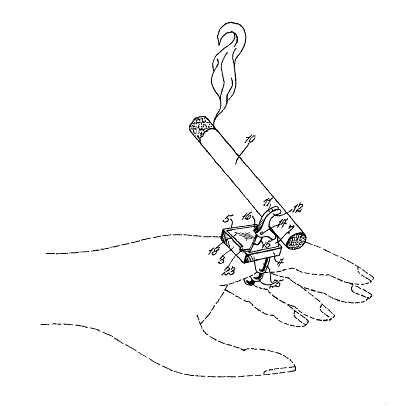
This should have caught on — Watson P. Aull’s “cigarette ring,” patented in 1938, clamps a cigarette in a ring worn on the left forefinger, so that the smoker has full use of her hands.
Here’s a related stunt from R.M. Abraham’s Diversions & Pastimes (1933):
“A cigarette may be lit quite easily by holding it 4 or 5 inches above the flame of the match.”
I haven’t tried it.